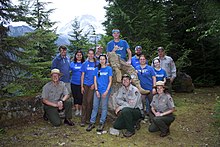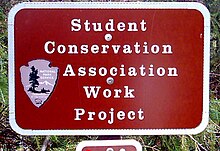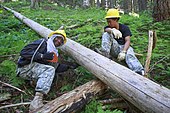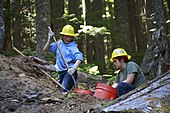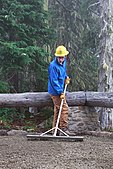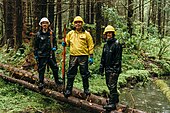
The Civilian Conservation Corps (CCC) was a voluntary government work relief program that ran from 1933 to 1942 in the United States for unemployed, unmarried men ages 18–25 and eventually expanded to ages 17–28. The CCC was a major part of President Franklin D. Roosevelt's New Deal that supplied manual labor jobs related to the conservation and development of natural resources in rural lands owned by federal, state, and local governments. The CCC was designed to supply jobs for young men and to relieve families who had difficulty finding jobs during the Great Depression in the United States. There was eventually a smaller counterpart program for unemployed women called the She-She-She Camps, which were championed by Eleanor Roosevelt.

The National Park Service (NPS) is an agency of the United States federal government, within the U.S. Department of the Interior. The service manages all national parks; most national monuments; and other natural, historical, and recreational properties, with various title designations. The United States Congress created the agency on August 25, 1916, through the National Park Service Organic Act. Its headquarters are in Washington, D.C., within the main headquarters of the Department of the Interior.

Appalachian Mountain Club (AMC) is the oldest outdoor group in the United States. Created in 1876 to explore and preserve the White Mountains in New Hampshire, it has expanded throughout the northeastern U.S., with 12 chapters stretching from Maine to Washington, D.C. The AMC's 90,000 members, its advocates, and supporters mix outdoor recreation, particularly hiking and backpacking, with environmental activism. Additional activities include cross-country skiing, whitewater and flatwater canoeing and kayaking, sea kayaking, sailing, rock climbing and bicycle riding. The Club has about 2,700 volunteers, who lead roughly 7,000 trips and activities per year. The organization publishes a number of books, guides, and trail maps.
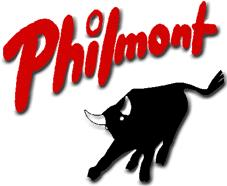
Philmont Scout Ranch is a ranch located in Colfax County, New Mexico, United States, near the village of Cimarron; it covers 140,177 acres (56,728 ha) of wilderness in the Sangre de Cristo Mountains on the east side of the Cimarron Range of the Rocky Mountains. Donated by oil baron Waite Phillips, the ranch is owned and operated by the Boy Scouts of America. It is a National High Adventure Base where crews of Scouts and Venturers take part in backpacking treks and other outdoor activities. By land area, it is one of the largest youth camps in the world. During the 2019 season, between June 8 and August 22, an estimated 24,000 Scouts and adult leaders backpacked through the Ranch's extensive backcountry. That same year 1,302 staff were responsible for the Ranch's summer operations.

Leave No Trace, sometimes written as LNT, is a set of ethics promoting conservation of the outdoors. Originating in the mid-20th century, the concept started as a movement in the United States in response to ecological damage caused by wilderness recreation. In 1994, the non-profit Leave No Trace Center for Outdoor Ethics was formed to create educational resources around LNT, and organized the framework of LNT into seven principles.
- Plan ahead and prepare
- Travel and camp on durable surfaces
- Dispose of waste properly
- Leave what you find
- Minimize campfire impacts
- Respect wildlife
- Be considerate of other visitors

NOLS is a non-profit outdoor education school based in the United States dedicated to teaching environmental ethics, technical outdoor skills, wilderness medicine, risk management and judgment, and leadership on extended wilderness expeditions and in traditional classrooms. It was previously known as the National Outdoor Leadership School, but in 2015, this label was retired in favor of the independent "NOLS". The "NOLS" mission is to be the leading source and teacher of wilderness skills and leadership that serve people and the environment. NOLS runs courses on six continents, with courses in a variety of wilderness environments and for almost any age group.

Conservation Volunteers Australia is an Australian not-for-profit conservation organisation that attracts and co-ordinates volunteers for environmental restoration projects.
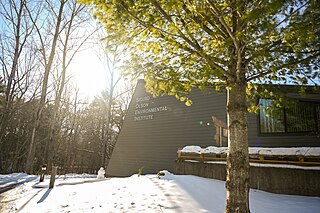
The Sigurd Olson Environmental Institute is an outreach arm of Northland College in Ashland, Wisconsin. The institute originated in 1971 at an environmental conference at Northland that hosted Sigurd Olson as a speaker. Robert Matteson was the founder of the Institute. The Institute opened in Spring, 1972.

Sx̱ótsaqel/Chilliwack Lake Provincial Park is a provincial park in British Columbia, Canada. Covering 92.58 km2, the park is located 150 km east of Vancouver in the Chilliwack River Valley.
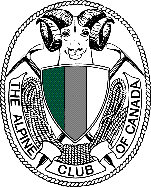
The Alpine Club of Canada (ACC) is an amateur athletic association with its national office in Canmore, Alberta that has been a focal point for Canadian mountaineering since its founding in 1906. The club was co-founded by Arthur Oliver Wheeler, who served as its first president, and Elizabeth Parker, a journalist for the Manitoba Free Press. Byron Harmon, whose 6500+ photographs of the Canadian Rockies in the early 20th century provide the best glimpse of the area at that time, was official photographer to the club at its founding. The club is the leading organization in Canada devoted to climbing, mountain culture, and issues related to alpine pursuits and ecology. It is also the Canadian regulatory organization for climbing competition, sanctioning local, regional and national events, and assembling, coaching and supporting the national team.

The Washington Conservation Corps (WCC) is a sub-agency of the Washington State Department of Ecology. WCC members work on projects in their communities, from habitat restoration, to trail construction, to natural disaster response. WCC members are active across the state of Washington and are a part of the state and nationwide disaster response network.

The Montana Conservation Corps (MCC) is a young adult voluntary development program modeled after the Civilian Conservation Corps of the 1930s, using conservation projects to foster citizenship and personal growth in its members. The MCC operates crews in four towns throughout Montana: Missoula, Kalispell, Helena, and Bozeman. In addition MCC's central office is located in Bozeman.
The National Park Foundation (NPF) is the official charity of the National Park Service (NPS) and its national park sites. The NPF was chartered by Congress in 1967 with a charge to "further the conservation of natural, scenic, historic, scientific, educational, inspirational, or recreational resources for future generations of Americans." The NPF raises private funds for the benefit of, or in connection with, the activities and services of the National Park Service.

The Youth Conservation Corps(YCC) is a paid summer youth work program in federally managed lands. The National Park Service, US Forest Service, US Fish and Wildlife Service and Bureau of Land Management employ teens each summer to participate in the YCC. The YCC has introduced young Americans to conservation opportunities in public lands since the program was created in 1970. In the late seventies and early eighties the program included a grant-in-aid component that funded state and local YCC projects nationwide. This element fell to 1982 budget cuts, but several states continued the effort with their own funds. Some employees currently working in land management agencies were introduced to their profession through the YCC.
The Public Land Corps (PLC) is a work and education program for young people and veterans that is run by the United States land management agencies in association with state conservation and service corps. The objective is the rehabilitation and restoration of public land resources and infrastructure. The Public Land Corps was authorized by the National and Community Service Trust Act on May 27, 1993, H.R. 2328. The 21st Century Conservation Service Corps Act in 2019 allowed Public Land Corps to partner with more federal agencies on conservation and restoration projects and created the Indian Youth Service Corps within the Public Land Corps.

Grand Canyon Conservancy, formerly known as Grand Canyon Association, is the National Park Service's official non-profit partner of Grand Canyon National Park, raising private funds, operating retail shops within the park, and providing premier guided educational programs about the natural and cultural history of the region. Supporters fund projects including trails and historic building preservation, educational programs for the public, and the protection of wildlife and their natural habitat.
Washington Trails Association (WTA) is a non-profit organization that advocates protection of hiking trails and wilderness, conducts trail maintenance, and promotes hiking in Washington state. Their principal values emphasize the benefits of nature, the willingness of hikers to protect trails, and the importance of ensuring that the outdoors is made accessible. Its offices are currently located on the corner of Second and Cherry in Downtown Seattle.
Elizabeth Cushman Titus Putnam is an American conservationist and founder of the Student Conservation Association.
Virginia Hill Wood was an American environmental activist and a pioneer in the Alaskan conservation movement. Ginny Wood co-founded the Alaska Conservation Society in 1960 with her then husband, Morton "Woody" Wood.
